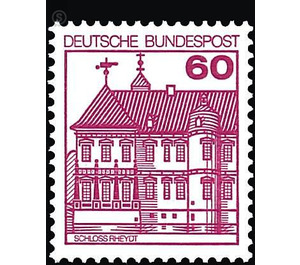Postage stamp: castles and palaces - Germany / Federal Republic of Germany 1979 - 60 Pfennig
Theme: Architecture
| Country | Germany / Federal Republic of Germany |
| Issue Date | 1979 |
| Face Value | 60.00 |
| Color | red |
| Perforation | K 14 |
| Printing Type | Lithography |
| Stamp Type | Postage stamp |
| Item Type | Stamp |
| Chronological Issue Number | 915 |
| Chronological Chapter | GER-BRD |
| SID | 423696 |
| In 97 Wishlists | |
Color matching to the usual postage stamp basic colors The 60 Pf value (red) with the Rheydt lock as a motif replaces the gray-brown 60 Pf value (motif: Marksburg); he appears at the same time and the same motif as the inscription Deutsche Bundespost Berlin. Rheydt Castle, an important work of the Renaissance with a magnificent bay window, contains a rich museum. Around 1180, the lords of Rheydt sold the castle to the archbishop of Cologne, who soon transferred it to the family of Heppendorf. In 1307 feudal rights were granted to the Counts of Jülich; until 1794 Rheydt formed a jülchian subjugation. Under Gerhard II von Heppendorf the castle was described as a "robber-knight's nest"; City and landscape Liege equipped with retaliation Cologne, a retaliatory campaign and destroyed it in 1464. Re-established, she came to 1500 (until 1794) to the Lords of Bylandt; In 1558, they had the castle styled in Renaissance style by Maximilian Pasqualini around 1570, rebuilt the medieval fortresses and expanded the fortifications. Hessian troops damaged it in 1644, and in 1917 it acquired the city of Rheydt. Since 1923, it has served as a museum. Schloss Rheydt, an early creation of the German Renaissance, has two castles: We first enter the Torburg (1570-1591). Obtained is the gatehouse made of brick, to which a bridge leads (formerly drawbridge, openings for the chain visible), with a beautiful portal, watchmen and loopholes. The side wing houses a restaurant. From the same time as the outer bailey come the fortifications that pentagonally enclose the entire complex. We see double trenches, remains of the Walles and the corner bastions with underground passages and casemates; The model was the citadel of Jülich with its Italian bastion system. Now we reach the inner bailey (1556 to 1570) with projecting corner buildings. Their portal also shows the devices for the drawbridge next to the half-columns. The west wing was destroyed in 1644. The castle itself, in brick, has sandstone structure. The oldest part is the northwest tower (probably second half of the 14th century). The western side wings (without the Erkerausbau) had Wilhelm von Nesselrode (1468-1500) rebuilt. His back still shows the original layout of the upper floor. The main building was created by Adrian von Bylandt (1524-1549) as a late Gothic fortress house (similar to Burg Konradsheim) with side portal, round tower in the middle of the front and surrounding cornice. Under Otto von Bylandt was 1558 to 1570 the Renaissance complex; The plans were created by Maximilian Pasqualini, as proved by the agreement with the Jülich castle building. The building sculpture points to the workshop of Wilhelm Vernukken. The rich frontal façade, showing the forms of the Roman High Renaissance, and the loggia on the back (reminiscent of the early Italian Renaissance, an arcade courtyard was planned) were added. Mainly decorative means, combined with Italian influences and Dutch-influenced decorations, designed the castle to the Renaissance castle. Inside, on the ground floor, there is the spacious Knight's Hall with entrance hall, ladies room and small vaulted chapel. 18th century furniture and portraits are noteworthy. The upper floor houses the municipal museum (founded in 1905, since 1923 in the castle), rebuilt in 1953 as a museum of art and culture of the Renaissance and Baroque. It illustrates the culture of a German noble residence in the 16th and 17th centuries in furniture, pictures and equipment, especially from the Rhenish culture. Noteworthy are valuable tapestries, manuscripts and books, silver work, coins and antique cabaret. In the outer bailey we find collections of finds, bourgeois and peasant culture and a weaving department. (Text: German Castle Association e.V. Braubach - Dr. W. Avenarius)


